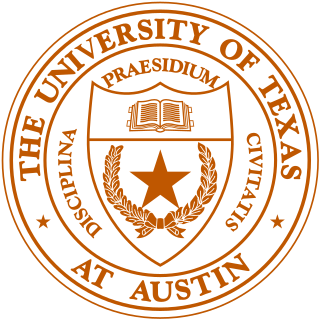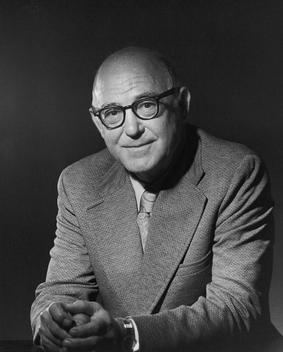Related Research Articles

The Sudbury Neutrino Observatory (SNO) was a neutrino observatory located 2100 m underground in Vale's Creighton Mine in Sudbury, Ontario, Canada. The detector was designed to detect solar neutrinos through their interactions with a large tank of heavy water.

The University of Texas at Austin is a public research university in Austin, Texas. It is the flagship institution of the University of Texas System. With 52,384 students as of Fall 2022, it is also the largest institution in the system.

McDonald Observatory is an astronomical observatory located near unincorporated community of Fort Davis in Jeff Davis County, Texas, United States. The facility is located on Mount Locke in the Davis Mountains of West Texas, with additional facilities on Mount Fowlkes, approximately 1.3 kilometers (0.81 mi) to the northeast. The observatory is part of The University of Texas at Austin. It is an organized research unit of the College of Natural Sciences.
The Robert J. Trumpler Award of the Astronomical Society of the Pacific is given annually to a recent recipient of the Ph.D degree whose thesis is judged particularly significant to astronomy. The award is named after Robert Julius Trumpler, a notable Swiss-American astronomer (1886–1956).

William Johnson McDonald was a Paris, Texas banker who left $850,000 to the University of Texas System to endow an astronomical observatory.

The Hobby–Eberly Telescope (HET) is a 10-meter (30-foot) aperture telescope located at the McDonald Observatory in Davis Mountains, Texas.

José Antonio Navarro was a Texas statesman, revolutionary, rancher, and merchant. The son of Ángel Navarro and Josefa María Ruiz y Peña, he was born into a distinguished noble family at San Antonio de Béxar in the Viceroyalty of New Spain. His uncle was José Francisco Ruiz and his brother-in-law was Juan Martín de Veramendi.
Harold Lester Johnson was an American astronomer.

George Eastland Christian Jr. was an American journalist and White House staffer, who served as the twelfth White House Press Secretary from 1966 to 1969.

William David McElroy was an American biochemist and academic administrator.

KUT is a listener and community supported public radio station based in Austin, Texas. KUT is owned and operated by the University of Texas at Austin. It is the National Public Radio member station for central Texas. Its studio operations are located on campus at the Dealey Center for New Mediahttps://news.utexas.edu/2021/06/10/uts-belo-center-for-new-media-renamed-the-g-b-dealey-center-for-new-media/]. KUT is one of three radio outlets based on UT campus alongside student-run KVRX 91.7 FM and KUTX 98.9 FM.

The Harlan J. Smith Telescope is a 107-inch (2.7 m) telescope located at the McDonald Observatory, in Texas, in the United States. This telescope is one of several research telescopes that are part of the University of Texas at Austin observatory perched on Mount Locke in the Davis Mountains of west Texas. The telescope was completed in 1968 with substantial NASA assistance, and is named after Harlan James Smith, the first Texas director of McDonald Observatory. Smith was the Observatory Director for 26 years.

Harlan James Smith was an American astronomer. He served as director of the University of Texas McDonald Observatory from 1963 to 1989, where, among other accomplishments, he initiated the construction of the Harlan J. Smith Telescope, a 2.7-meter (107-inch) reflector bearing his name.

Roy Edward Nather was an American astronomer, who at the time of his death, was professor emeritus in Astronomy at University of Texas at Austin. He pioneered the fields of asteroseismology of white dwarfs, and observational studies of interacting binary collapsed stars.
David Stanley Evans was a British astronomer, noted for his use of lunar occultations to measure stellar angular diameters during the 1950s.
An extreme helium star is a low-mass supergiant that is almost devoid of hydrogen, the most common chemical element of the Universe. Since there are no known conditions where stars devoid of hydrogen can be formed from molecular clouds, it is theorized that they are the product of the mergers of helium-core and carbon-oxygen core white dwarfs.

StarDate is a science radio program of The University of Texas at Austin McDonald Observatory, broadcast on over 300 radio stations. It is a daily guide to the night sky and breaking astronomical news. Typically heard without formal introduction, StarDate is a self-contained science news feature interwoven with routine radio programming. It is the longest-running science outreach program on U.S. radio.
Thomas Flynn Edgar is an American chemical engineer.
Anita L. Cochran is an American astronomer, planetary scientist, and senior research scientist at the University of Texas at Austin. She is also the assistant director for research support at the McDonald Observatory. She focuses on the study of primitive bodies in the solar system and the composition of comets.
John Craig Wheeler is an American astronomer. He is the Samuel T. and Fern Yanagisawa Regents Professor of Astronomy Emeritus at the University of Texas at Austin. He is known for his theoretical work on supernovae. He is a past president of the American Astronomical Society, a Fellow of that society, and a Fellow of the American Physical Society.